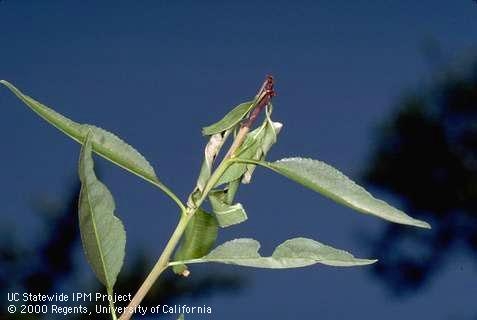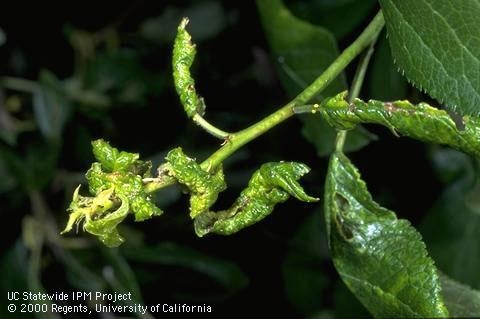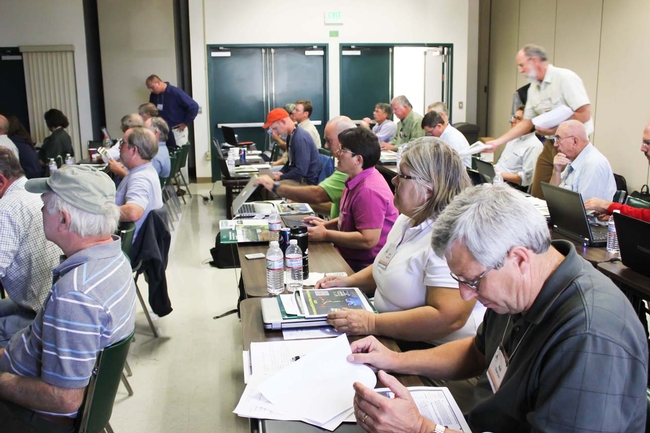Posts Tagged: integrated pest management systems
New videos from UC IPM help stone fruit growers and PCAs tackle pest problems.
Spider mites, fruit moth and twig borer larvae, aphids, and bark cankers are just a few pests that can wreak havoc on stone fruit trees. With spring well underway and trees in full bloom and beginning to develop fruit, it's time to monitor and take action before these pests get out of hand.
UC IPM teamed up with UC farm advisors to develop a series of how-to videos that can help growers and pest control advisers monitor for pests and damage and determine if and when treatment is needed.
In one video, Sacramento Area IPM Advisor Emily Symmes gives a brief overview of how to monitor for webspinning spider mites. Spider mites build up in stone fruit trees as the weather warms up. Late spring through summer is the ideal time to monitor for mites and their damage, which includes leaf stippling and webbing. If mites build up too much, leaves can drop, fruit may not fully develop, and branches and fruit can be exposed to sunburn.
Shoot strikes, or dead drooping leaf tips, are often seen on young peach and nectarine trees. In a second video, UC Sutter and Yuba County Farm Advisor Janine Hasey explains how to monitor for shoot strikes and how to distinguish the culprits, oriental fruit moth and peach twig borer. Although Oriental fruit moth and peach twig borer can bore into both foliage and fruit, they cause the most devastating damage by feeding on fruit. Early season monitoring and treatment can prevent future fruit loss.
In plum and prune orchards, leaf curl aphids and mealy plum aphids cause leaves to curl and become distorted. Aphids produce honeydew, which can lead to the development of sooty mold, causing fruit to crack and blacken. Aphids are often present when leaves start to grow. In his video, Rick Buchner, UC farm advisor for Tehama County, discusses how to monitor for aphids and explains how to decide when treatment is warranted.
In a final video, UC Sacramento County Farm Advisor Chuck Ingels teaches how to distinguish Phytophthora root and crown rot from bacterial canker. The two diseases are often confused because they both cause bark cankers. Phytophthora root and crown rot is confined to the lower trunk, but when a bacterial canker infection occurs in the tree trunk, the diseases can often be confused. Bacterial canker can be confirmed by cutting away the outer bark and looking for characteristic red flecks on the inner bark. Correct identification of these diseases will help in choosing a management strategy.
You can find all of these how-to videos on the UC IPM video library page. For specific information about managing pests in stone fruits or other crops, see the Pest Management Guidelines.

Webbing caused by webspinning spider mites.

Shoot strike caused by oriental fruit moth.

Leaf distortion caused by leaf curl plum aphid.

Reddish flecking symptoms of bacterial canker.
Come visit UC Division of Agriculture and Natural Resources at the 2015 World Ag Expo.
On your tour of World Ag Expo 2015, make sure to come by the University of California Division of Agriculture and Natural Resources (UC ANR) exhibits at Pavilion A and B (northwest corner of the Expo), clustered at booths 1411, 1412, 1512 and 1513.
Booth 1411 - UC Cooperative Extension, Tulare County office
Serving local Californians since 1913, UC Cooperative Extension (UCCE) maintains offices throughout the state through a partnership between local county governments, UC ANR, and the US Department of Agriculture. UC Cooperative Extension advisors help identify and solve local problems through research and educational programs that focus on the evolving needs of growers, youth, families, agencies, policy makers and the general public.
Staff will provide specialized programming for an Agriculture Day (Tuesday, Feb. 10), a 4-H/Nutrition Day (Wednesday, Feb. 11), and a UC Master Gardener Day (Thursday, Feb. 12).
The Research and Extension Center System (RECS), which extends from the Oregon border in the north, through the Sierra Foothills and Central Valley, and along the Pacific Coast and south to the border of Mexico, includes sites in a wide variety of California ecosystems, allowing researchers and extension educators to effectively address regional challenges and issues. It is the only UC statewide program that can provide researchers with a premier research management organization including land, labor, facilities and equipment, in a wide variety of real-world, outdoor growing environments, where they can pursue new knowledge for the benefit of agricultural and resource science, industry, and the general public.
Centers are also focal points for community participation and active involvement in finding ways to address current and relevant regional agricultural and natural resource challenges. The RECS centers support projects involving county-based cooperative extension advisors and campus-based research specialists, as well as researchers from Land-Grant institutions in other states, the California State University (CSU) system and USDA as they conduct their research and education programs.
Booth 1412 - UC ANR Kearney Agricultural Research & Extension Center (KARE)
Officially dedicated in 1965, KARE has achieved international acclaim for leadership in the development of new fruit, nut and grape varieties, innovative cultural and irrigation practices, pest and disease management techniques, and new understandings of postharvest biology. KARE plays a leadership role in maintaining the quality of California's rural environment, with programs in air, soil and water quality and mosquito management.
Booth 1512 - UC ANR Lindcove REC (LREC)
Established in 1959 by San Joaquin Valley citrus growers, Lindcove REC covers more than 100 acres growing more than 400 citrus varieties. At LREC, scientists conduct research to evaluate new varieties of citrus and improved citrus-growing techniques and new ways to manage pests. Extension educational programs carry the practical results of this research to citrus industry clientele and the general public.
Booth 1513 - University of California Division of Agriculture and Natural Resources
Come learn more about the University of California's Division of Agriculture and Natural Resources, our history, and our research and programs across the state. You can also download our Cultivating California brochure.
UC ANR is a statewide network of University of California researchers and educators dedicated to providing individuals, communities, and industries with science-based information and solutions to address the important issues California is currently facing.
- 4 Agricultural Experiment Station – UC campus-based research
- Research and Extension Centers (REC)
- 50+ UC Cooperative Extension (UCCE) County Offices
- 6 statewide programs focused on high-priority concerns
- Agricultural Issues Center (AIC)
- California Naturalist Program
- IGIS - Informatics and Geographic Information Systems
- Integrated Pest Management
- Master Gardener Program
- Sustainable Agricultural Research and Education Program (SAREP)
- Youth, Families and Communities Program
UC ANR is an engine for problem solving, working with industry to develop and improve agricultural markets, help keep a good balance in international trade, address environmental concerns, protect plant health, and provide farmers with scientifically tested production techniques and the tools necessary to maintain a safe food supply for consumers.
Other UC ANR booths:
- Outdoor booth M54 - UC Conservation Agriculture Systems Innovation (CASI) –
CASI has over 2,100 university, farmer, National Resources Conservation Service, and private-sector partners working to develop and evaluate a wide range of cropping system alternatives for California's diverse cropping sectors. The practical coupling of agricultural production and strategies for water conservation via efficient tillage and irrigation are important aspects of CASI's current work.
- Booth 6014 - UC Davis Veterinary Medicine Teaching and Research Center
- Booths 8013 & 8014 - UC Davis College of Agricultural and Environmental Sciences

Map of the UC ANR network.
UC biological control scientist Marshall W. Johnson retired in June
After a successful tenure as an entomology professor and researcher at the University of Hawaii, Manoa, Marshall W. Johnson added a 10-year capstone to his career as UC Cooperative Extension specialist and research entomologist in the Department of Entomology at UC Riverside, based at the UC Kearney Agricultural Research and Extension Center. He retired at the end of June.
Johnson traces his interest in insects to a visit with a family friend on the outskirts of his hometown, Roanake, Va., when he was 10 years old. He was intrigued by a copy of “A Golden Guide to Familiar American Insects,” and the friend gave it to him. “That’s how I got started,” Johnson said. He never looked back.
Johnson earned bachelor’s and master’s degrees in entomology at North Carolina State University and in 1974 completed a Ph.D. in entomology at UC Riverside. After conducting short stints of entomological research at two locations on the mainland, he moved to Hawaii in 1983 to serve as a professor and focus his research on biological control.
In Hawaii watermelon production, Johnson was able to help farmers reduce pesticide use by 90 percent by showing that pesticide applications were killing natural enemies of a Liriomyza leafminer pest they were trying to control. He also worked on biological control of pests on cucumbers, tomatoes, green onions, pineapple, papaya and coffee.
In 1995, Johnson took a six-month sabbatical leave to UC Davis and realized how much he missed living on the mainland. He started looking for a new job and eventually was offered the combined extension and research position at his alma mater, UC Riverside, based at the off-campus research center in Parlier, Calif.
Johnson’s arrival coincided with the introduction of olive fruit fly in California, a serious pest that has devastated olive production in the Mediterranean region for more than 2,000 years. Olive fruit fly was detected in Los Angeles in 1998, and by 1999 had made its way into the San Joaquin Valley, the leading producer of the state’s olives.
To the great relief of valley olive growers, Johnson and his biological control colleague Kent Daane, UCCE specialist in the Department of Environmental Science, Policy and Management at UC Berkeley, found that hot summertime temperatures in the valley depress olive fly populations. But that didn’t provide a statewide solution.
Johnson and Daane worked together to introduce exotic natural enemies of the pest from Africa. The beneficial insects have been released from quarantine and introduced at several locations in California, with recovery of one species in the San Luis Obispo and Redwood City areas.
“We think it’s on the way to establishment. That’s a good sign,” Johnson said. “Now we're waiting to see if the parasite’s presence will have an impact on olive fly populations.”
Johnson was also involved in research that showed the Central Valley isn’t as hospitable to glassy-winged sharpshooters as other parts of the state. When it gets very cold, GWSS cannot move or feed. They either starve or get dehydrated.
“About every 2 out of 10 years, it gets cold enough in the valley that glassy-winged sharpshooter populations are reduced 90 to 95 percent,” Johnson said. “It is unlikely glassy-winged sharpshooters would ever become well established in the Sacramento Valley or the northern San Joaquin Valley. But it is well established in the Bakersfield area.”
Johnson ended his career with a video production project designed to raise awareness about integrated pest management. Posted on the website Extending Orchard IPM Knowledge in California, the videos include interviews with IPM practitioners, researchers and farmers plus overviews of specific pest control techniques, such as biological control, cultural practices and pheromones.
For his research and extension efforts, Johnson received numerous awards and honors over the years. Most recently, he was named “Distinguished Scientist of the Year,” by the International Organization for Biological Control. He is an elected fellow of both the Entomological Society of America and the American Association for the Advancement of Science. He was author or co-author of more than 200 peer-reviewed articles, book chapters, and extension publications.
During retirement, Johnson plans to spend more time pursuing the art of photography, mainly landscapes and seascapes, which he captures during travels around the United States. Johnson also plans to continue cataloging the history of the family of his mother, whose maiden name was “Marshall.” He has already traced his lineage back to a 1729 immigrant from Ireland. An earlier ancestor, a member of the provincial council in Pennsylvania, was governor for one day when William Penn was absent from the colony, Johnson said.

Marshall W. Johnson
Bringing integrated pest management to bear on natural resource concerns
A training and certification workshop was held at UC Kearney Agricultural Research and Extension Center for agricultural pest management professionals and successfully added 23 individuals to the registry of Technical Service Providers .
The goal of the workshop was to train, certify and register individuals with integrated pest management (IPM) expertise to support the mission of the United States Department of Agriculture Natural Resource Conservation Service (NRCS) as Technical Service Providers. These new Technical Service Providers will support the mission of NRCS by augmenting highly technical areas in the development and documentation of IPM Conservation Activity Plans. Using private sector expertise in conjunction with NRCS personnel and UC IPM Pest Management Guidelines, additional services can be provided to landowners seeking mitigation to natural resource concerns.
The workshop was conducted with University of California Agriculture and Natural Resources, UC Cooperative Extension, the UC Statewide IPM Program, NRCS and the Association of Applied IPM Ecologists.
NRCS provides expertise to landowners to address and mitigate on-farm resource concerns that affect air, water, wildlife, soil and humans. In recent years, there have been increased requests for assistance to mitigate resource concerns linked to pests or pest management activities.
One of the trainees was Sylvie Robillard from Tecolote IPM Consulting, who has been a pest control adviser specializing in IPM consulting for 25 years in Fresno, Kern and Tulare counties. She feels that the use of Technical Service Provider consultants will increase the number of farmers using conservation activity plans for IPM. Farmers currently using Robillard’s services already practice IPM and have a desire to conserve natural resources so that they can continue to farm. Robillard believes that by using the USDA NRCS tools and being registered as a Technical Service Provider, she can better help her clients document and refine their conservation plans. With more Technical Service Providers, more farmers can become aware of and use Technical Service Providers to help create conservation activity plans for IPM and implement conservation efforts in accordance with NRCS guidelines.

Agricultural pest management professionals training to become registered Technical Service Providers capable of developing conservation activity plans that meet integrated pest management and United States Department of Agriculture Natural Resources Conservation Service guidelines.